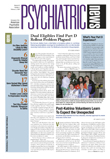Although not always very apparent, individual APA members can play an important role in influencing the Association's policies and functioning. We can help shape the organization and psychiatry by communicating with APA leaders, writing articles for psychiatric publications, voting in elections, and even running for elected office. Constructive ideas can also be conveyed to APA by residents and other members who develop “action papers,” documents that are formally reviewed by the APA Assembly and considered for implementation.
Processing an action paper usually requires several steps before final approval by the APA Board of Trustees.
It requires involvement of the APA Assembly, where most action papers originate. The Assembly is a legislative body made up of locally elected representatives from APA's 74 district branches and seven Area Councils (Area Councils are primarily regional links between the Assembly and the district branches). While any APA member can write an action paper, an Assembly representative is the conduit for bringing it before the Assembly.
Most APA district branches have one Assembly representative, but larger branches can have two or more, depending on the size of the membership. District branches with only one representative also have a deputy representative to the Assembly, who only has a vote in the Assembly in the absence of the representative.
In addition, a representative and deputy representative from each of APA's seven caucuses represent psychiatrists from minority/underrepresented groups. More than a dozen other psychiatric organizations also have an Assembly liaison.
The Assembly also has representatives from two key member categories—members-in-training and early career psychiatrists. Each of the seven Areas sends a member-in-training and early career psychiatrist representative and deputy representative to Assembly meetings. To find out who your Assembly representatives are, you can contact your district branch. A listing of all representatives can be accessed on APA's Web site at<www.psychiatry.org> by clicking on “Members Corner” and then “Directory of Components.”
Here are a few tips to help those of you who may want to write an action paper for the Assembly. When writing the paper, make sure that your language is concise, particularly when you describe the steps you would like APA to take to address the problem you raise. Your paper is more likely to be be successful if you have other psychiatrists, particularly those familiar with the working of the Assembly, review it before it is introduced.
Action papers are laid out in several sections so their format is uniform. Key sections are (1) subject, (2) intent, (3) description of the problem the paper addresses, (4) alternatives and recommendations for solving the problem, (5) estimated cost (APA's Office of Finance and Business Operations can help develop the estimate), and (6) into which of APA's five strategic goals this paper best fits.
Action papers are first submitted to the APA Governance Office, where they are reviewed and shared with the Assembly Rules Committee. From here papers are assigned to Assembly reference committees or to Area Councils to review at an Assembly meeting. There are two Assembly meetings every year, one in November and one just before the APA annual meeting, usually in May.
Once presented at an Assembly meeting, action papers can be accepted as written, accepted with changes, or rejected. In addition, sometimes papers are sent to a committee or council for further discussion and then returned to the Assembly at a future meeting.
Action papers approved by the Assembly are sent to the Board of Trustees for final approval.
Psychiatry residents have been active in writing action papers for many years. During the Assembly meeting in May 2005, this was particularly evident.
Six papers were written by members-in-training; all of the papers were passed as written or with some modification. The proposals included adding free seats for residents at courses during the APA annual meeting, ensuring residents' presence on the Scientific Program Committee (which develops and implements the APA annual meeting programs), and exploring the inclusion of fetal alcohol spectrum disorders in future editions of the DSM.
When APA members participate in the Association's functioning, it strengthens the Association and ensures that as many voices as possible are heard. The problems facing our field are multiple and complex. It is likely that we will move faster toward solutions if the innovative ideas so many residents have are shared with the rest of the psychiatric community.▪

